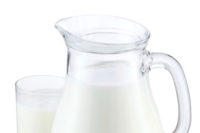Rat Study: Goat Milk versus Cow Milk
December 9/Food Weekly Focus -- According to recent research published in the Journal of Dairy Research, "Consumption of whole milk and related dairy products has decreased considerably as a result of negative aspects associated with the consumption of saturated fats. The main difference between the composition of goat milk and cow milk concerns the composition of the fat, that of goat milk containing a larger proportion of medium-chain triglycerides."
"The metabolic utilization of these compounds is fundamentally oriented toward their use as sources of energy, and they may even contribute to the synthesis of proteins. This study was carried out, using 40 rats at weaning, in order to determine whether, on the basis of their fat and protein composition, there is any difference between the nutritional utilization of the N and the energy from goat and cow milk. Eight animals were killed on arrival at the laboratory, and the rest were divided into four groups of eight animals and killed at the end of the experiment. Each group was given a different diet: diet 1 contained fat and protein from goat milk; diet 2 had fat from cow milk and protein from goat milk; diet 3 had fat from goat milk and protein from cow milk; diet 4 had fat and protein from cow milk. The animals were allowed to feed ad libitum for 30 days and a balance assay was performed during the final seven days to determine N and energy utilization. At the same time and by the comparative slaughter method, the protein and fat deposition for each group was established.
"It was concluded that goat milk protein is more digestible than that of cow milk. Moreover, the metabolic utilization of digestible N was found to be dependent on the sources of both the protein and the fat in the diet; a higher degree of utilization was recorded for the digestible N obtained using diets with protein or fat from goat milk. Consumption of diets with goat milk fat led to a lower level of thermogenesis associated with protein oxidation and a higher one for that associated with fat oxidation, which in turn implied a protein-sparing effect of the goat milk fat," wrote L.S. Ceballos and colleagues.
The researchers concluded, "These results should be taken into account when deciding upon the type of goat milk to be used (whole, skim or semi-skim), in accordance with the dairy product to be produced from this milk."
Ceballos and colleagues published their study in the Journal of Dairy Research ("Utilization of Nitrogen and Energy from Diets Containing Protein and Fat Derived from Either Goat Milk or Cow Milk." Journal of Dairy Research, 2009;76(4):497-504).
For additional information, contact M.R.S. Sampelayo, CSIC, Estac Experimental Zaidin, Institute Animal Nutrition, Prof Albareda 1, E-18008 Granada, Spain.
From the December 21, 2009, Prepared Foods E-dition
Looking for a reprint of this article?
From high-res PDFs to custom plaques, order your copy today!




